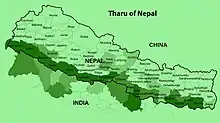Tharu languages
The Tharu (Tharu: थारु, Hindi: थरुवा) or Tharuhat (Nepali: थरुहट) languages are any of the Indo-Aryan languages spoken by the Tharu people of the Terai region in Nepal, and neighboring regions of Uttarakhand, Uttar Pradesh and Bihar in India.[2][3]
| Tharu | |
|---|---|
| थारु, थरुवा, थरुहट | |
 Regions in Nepal and India with significant Tharu population | |
| Native to | Nepal, India |
| Ethnicity | Tharu (incl. Bhoksa) |
Native speakers | 1.53 million in Nepal (2011 census)[1] 400,000 or more in India (1997–2007)[1] |
| Devanagari | |
| Language codes | |
| ISO 639-3 | Variously:thl – Dangaura Tharutkt – Kathoriya Tharuthr – Rana Tharuthe – Chitwania Tharuthq – Kochila Tharutkb – Buksa Tharusoi – Sonha |
| Glottolog | thar1284 |
Tharu languages are spoken in the Tharu community. This languages are similar to other neighboring languages. Tharu language is one of the major language spoken in Nepal.
Although their own precise classification within Indo-Aryan remains uncertain, Tharu languages have superficial similarities with neighbouring languages such as Kumaoni, Awadhi, Maithili, Bengali, Rajbanshi and Bhojpuri. The lexicon of certain Tharu households is indicative of an archaic, 'indigenous' substratum, potentially predating both Sino-Tibetan or Indo-Aryan settlement. Tharu languages appear to be transitional within the context of Indo-Aryan.[4]
Chitwania Tharu is spoken by approximately 250,000 speakers east of the Gandaki River, in and around the Chitwan Valley. Chitwania, as a whole, has superficial similarities with Awadhi. Nevertheless, certain Chitwania variants appear to have considerable lexical similarities with Manchad, a Sino-Tibetan language.[5]
Dangaura, Rana, and Buksa refer to a triumvirate of mutually-intelligible Tharu variants spoken west of the Gandaki River, spoken by approximately 1.3 million people. Furthermore, an additional variant of Tharu, known as Sonha, is largely mutually intelligible with Dangaura.
Kochila, a diverse Tharu variant, is also spoken by approximately 250,000 people, in regions of eastern Nepal. Kochila Tharu communities are not found in isolation, but live in districts intermixed with speakers of other languages. “In contrast with western Terai where the Tharus are the only and dominant ethnic minority, the eastern – especially the far eastern – Terai is inhabited by several ethnic groups with very different linguistic affiliation”. Many ethnic Kochila have adopted Maithili.[6]
Phonology
The following consists mostly of the Daungara and Rana dialects:
Consonants
| Labial | Dental/ Alveolar |
Retroflex | Post-alv./ Palatal |
Velar | Glottal | ||
|---|---|---|---|---|---|---|---|
| Stop/ Affricate |
voiceless | p | t | ʈ | tʃ | k | |
| aspirated | pʰ | tʰ | ʈʰ | tʃʰ | kʰ | ||
| voiced | b | d | ɖ | dʒ | ɡ | ||
| breathy | bʱ | dʱ | ɖʱ | dʒʱ | ɡʱ | ||
| Nasal | voiced | m | n | (ɲ) | ŋ | ||
| breathy | m̤ | n̤ | ŋ̈ | ||||
| Fricative | s | h | |||||
| Tap | voiced | ɾ | |||||
| breathy | ɾ̤ | ||||||
| Trill | voiced | (r) | |||||
| breathy | (r̤) | ||||||
| Lateral | voiced | l | |||||
| breathy | l̤ | ||||||
| Approximant | w | j | |||||
References
- Dangaura Tharu at Ethnologue (18th ed., 2015) (subscription required)
Kathoriya Tharu at Ethnologue (18th ed., 2015) (subscription required)
Rana Tharu at Ethnologue (18th ed., 2015) (subscription required)
Chitwania Tharu at Ethnologue (18th ed., 2015) (subscription required)
Kochila Tharu at Ethnologue (18th ed., 2015) (subscription required)
Buksa Tharu at Ethnologue (18th ed., 2015) (subscription required)
(Additional references under 'Language codes' in the information box) - Office of the Registrar General, India (2001). "Uttaranchal. Data Highlights: The Scheduled Tribes. Census of India 2001" (PDF). Retrieved 2008-03-16.
- Office of the Registrar General, India (2001). "Uttar Pradesh. Data Highlights: The Scheduled Tribes. Census of India 2001" (PDF).
- The Indo-Aryans of Ancient South Asia: Language, Material Culture and Ethnicity
- George van Driem, 2007, "Endangered languages of South Asia", in Matthias Brenzinger, Mouton de Gruyter
- Linguistic Survey of Nepal (LinSuN) Central Department of Linguistics Tribhuvan University, Nepal and SIL International 2013. "A Sociolinguistic Study of Kochila Tharu in Southeast Nepal" (PDF).
- Dhakal, Dubi Nanda. Notes on Rana Tharu Grammar Notes.
- Boehm, Edward D. (2003). A Descriptive Phonology of Dangaura Tharu.